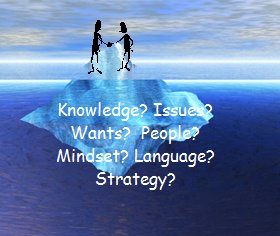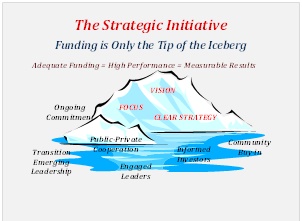SHARE:


Feb 17, 2016
Close Deals, Open Conversations
with an Iceberg
What do you explain that
-
Is
complex?
-
Requires
broad resources?
-
Seems
simple--or similar to others--but which you know isn’t?
Icebergs make
great metaphors for quickly addressing all of the above. Why?
-
Everyone
understands the associations evoked by an iceberg image: that what is below
the surface of an iceberg is significantly larger and
more consequential than what is visible to the naked eye.
-
Icebergs
are easy to imagine and create in a presentation or on the back of a napkin.
-
Icebergs
stick in people’s memory.
Here are three
examples:
To Provide a Success Snapshot for New Hires
 I do a variety of seminars for clients, one of which is
Negotiate Like a Pro.
People always want the quick answer to how to be a better negotiator. They think
there is a magic bullet to getting a good deal. I use an iceberg to illustrate
that there is NO magic bullet to a good deal, that a good deal depends on a
number of hidden factors that people tend to overlook, e.g., Knowledge (of them,
yourself, the industry), the people (their styles, interests), etc. I do a variety of seminars for clients, one of which is
Negotiate Like a Pro.
People always want the quick answer to how to be a better negotiator. They think
there is a magic bullet to getting a good deal. I use an iceberg to illustrate
that there is NO magic bullet to a good deal, that a good deal depends on a
number of hidden factors that people tend to overlook, e.g., Knowledge (of them,
yourself, the industry), the people (their styles, interests), etc.
After we cover one area, I show the iceberg again and highlight the next factor,
so that by the end of the session, the cumulative effect of seeing the one
visual repeatedly drives home the importance of what needs to be planned before
going into a negotiating situation. Then, they use all the factors in a
negotiation case with better results than they would otherwise have realized.
Assuming you bring new people on board regularly or that you even coach
individuals, what training iceberg can you use to help them quickly grasp the
underlying success drivers for their job?
To Show Value to Clients or Colleagues
 Howard Benson, CEO,
National Community Development Services, Inc. an Atlanta
based community and economic development fundraising company builds value for
his services with the venerable iceberg. Howard Benson, CEO,
National Community Development Services, Inc. an Atlanta
based community and economic development fundraising company builds value for
his services with the venerable iceberg.
It is one thing to have a focus, vision and even a strategy, notes Howard, but
the iceberg image illustrates that without leadership, appropriate
public/private cooperation, informed investors who are courted by competing
organizations, and community buy-in, any fund-raising effort even with the best
goals in the world won’t be successful. And, of course, NCDS offers those
services.
The iceberg metaphor is useful to Howard in many ways. It can be
-
The basis for a full discovery/needs assessment discussion
-
A springboard for uncovering needs a client didn’t know he had
-
An easy-to-understand snapshot of his services
-
A simple way to identify key players in each area
-
The basis for laying out an approach or solution to a specific situation
What would your value iceberg to a new client look like?
To Position Your Market Expertise
 Branding to most people usually only means a logo, like Nike’s Swish. But
leading Atlanta brand identify firm Matchstic uses an iceberg to explain the
true complexity of a brand while simultaneously positioning itself as the
experts to handle your business. Branding to most people usually only means a logo, like Nike’s Swish. But
leading Atlanta brand identify firm Matchstic uses an iceberg to explain the
true complexity of a brand while simultaneously positioning itself as the
experts to handle your business.
-
“A brand isn’t just one thing. It’s the total of several pieces functioning
together to create a reputation. An iceberg is a good analogy for understanding
the complexity of a brand and all its parts. The tip of the
iceberg is your
brand name and brandmark. They’re the most simple and visual expressions of the
brand. Countries have flags, companies have logos. Too often a logo is seen as
something that exists on its own, disconnected, like a piece of ice instead of
the tip of the iceberg. A true brand mark is much more than a signature. Over
time, it becomes synonymous with the company, its reputation and its ethos.”
-
“Beneath the tip of the iceberg lies the larger visual identity system – the
overall look and feel. It determines elements such as color, fonts, graphic
styles, photography, key messages, voice and tone. Below the water lies the
unseen, yet all-important foundation of it all: the brand strategy. This work is
about defining the different aspects of the brand, including personality, core
purpose, positioning, target audiences and the central theme—the BIG IDEA.”
-
“All of the different parts of a brand work together to create a solid and
cohesive whole. Each piece is as important as the next and you can’t have one
without the support and strength of the others.”
What would your education & expertise iceberg look like?
Keep it Simple
Metaphors and Analogies make the complex simple and the simple meaningful. An
iceberg can do both for you.
.
Anne Miller
Make What You Say Pay! — with Metaphors
Latest Podcast
Bryon White, founder of
www.writeraccess.com and I get into
a lively discussion of why metaphors work. Listen
here.
 NEW! - Demo/Presentation Assessments: Start 2016 with a bang!
NEW! - Demo/Presentation Assessments: Start 2016 with a bang!
- Missing business?
- No time for training?
- Want to identify weak spots (Content, story, visuals, engagement,
relevance, impact)?
Call today for details on how easy,
cost-effective and practical it is to do an Assessment to fine-tune your
presentations. 212 876 1875 or
amiller@annemiller.com

Need Some "WOW" in Your Presentation or Demo?
Call today and turn your information that tells into a story
that sells.
212-876-1875
amiller@annemiller.com
"Anne has transformed the way we
engage with clients. I highly recommend her for demo/presentation training"
Trish Bertuzzi, Pres., The
Bridge Group, Inc.
|
